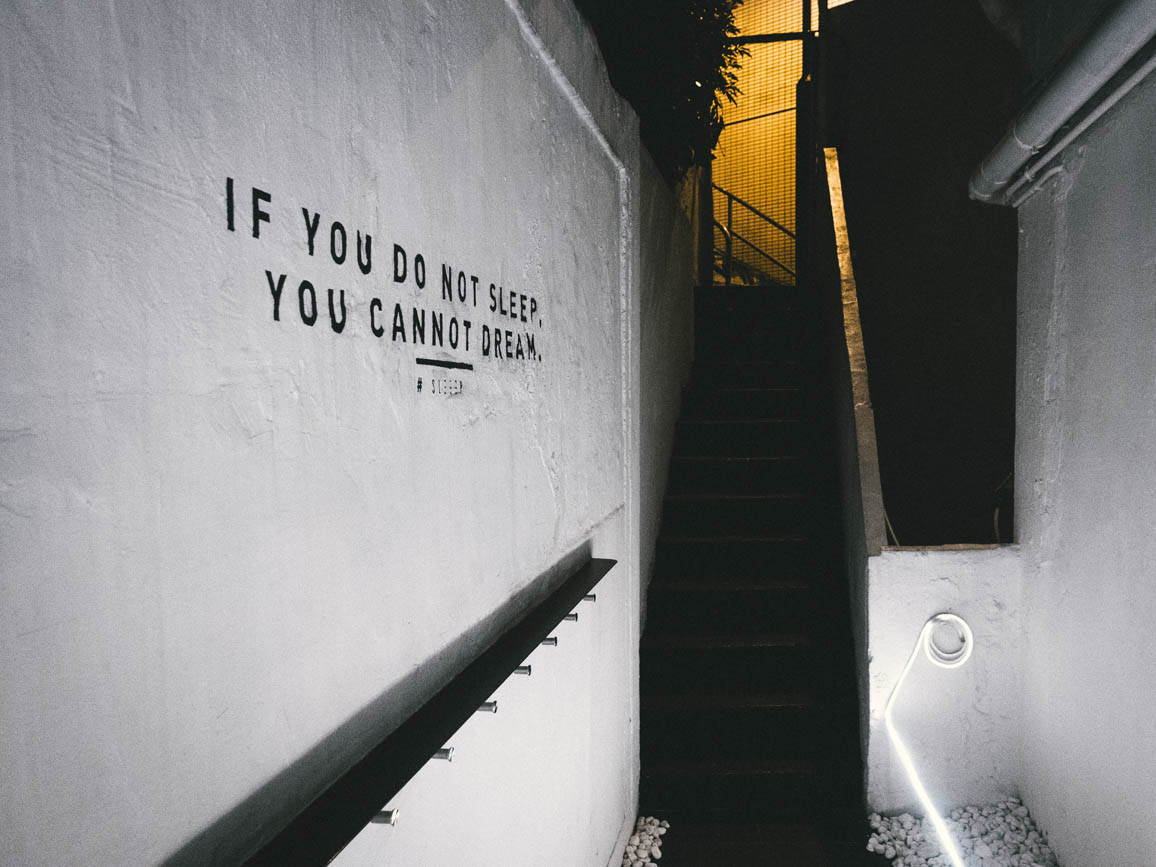- SLEEEP is Hong Kong’s first capsule hotel, a concept invented in Japan in the late 1970s that aims to provide cheap, convenient “sleeping pods” for travelers who do not require the services of a full hotel.
- I stayed at SLEEEP last March on a business trip to Hong Kong. It cost around $75 USD per night, cheap for a hotel on Hong Kong island, but other accommodations on Airbnb or in budget hotels can be had for cheaper.
- SLEEEP is ideally located and well-designed aesthetically, but its capsules get hot quickly and do not block out sound, making for a poor night of sleep.
It sounds great on paper: A budget hotel completely designed around getting you the best night of sleep. That’s the idea behind SLEEEP, Hong Kong’s first capsule hotel.
The reality, however, isn’t quite so relaxing.
Located in Sheung Wan, a hip neighborhood on Hong Kong Island near the main business district, SLEEEP caters to solo tourists, overworked Hong Kongers, and harried business travelers by offering them “a breathing space within a suffocating environment,” in the words of Jun Rivers, who co-founded the hotel with childhood friend Alex Klot.
“We truly believe that high-quality, sufficient sleep can take us further in both our personal and professional lives,” Rivers told Lifestyle Asia last year, shortly after it opened.
While it is ideally located and designed with an Apple-esque eye for minimalist design - it won silver for Design for Asia Awards 2017 - the hotel fails at its most basic purpose.
I stayed at SLEEEP last March on a business trip to Hong Kong. After a long couple of days reporting in Macau, I arrived at the hotel excited for an excellent night of sleep. Instead I found myself overheated, woken multiple times, and altogether turned off by the entire concept.
SLEEEP is located between Queen's Road Central and Gough Street, two winding roads in the Sheung Wan neighborhood of Hong Kong. There's a staircase halfway down the street. Walk up it to find SLEEEP.

It feels a little like looking for a secret passageway. When you start to see the cheeky messages related to sleep, you'll know you found it.

One of the best things about the hotel is how streamlined the experience is. There are no receptionists or keycards. You just walk up to the touchpad outside the door.

A QR code is sent to you on the day of your check-in. Simply scan the QR code on the scanner below the touchpad and the door to the hotel unlocks. SLEEP is cheap for a hotel on Hong Kong island at around $75 USD per night, but Airbnb and private guest-rooms can be had for much cheaper, particularly if you are willing to stay in Kowloon.

It was dead quiet when I entered, which boded well for my sleep. Since it was 11 p.m., I assumed anyone staying at SLEEEP would already be sleeping. A screen at the entrance displayed a message welcoming me to the hotel, and listing some helpful information.

I saw that several people had left their shoes under a bench by the door. Slippers were provided for padding around the tiny hotel. Seriously, it's small. The hotel is 367 square feet, according to Lifestyle Asia.

It's a little disorienting at first. I initially went to the wrong pod. Lights on your bunk flash when you check-in, but I failed to spot them as they weren't on the row visible from the entrance.

The hotel is all about function, not form. Everything from the WiFi password to the flooring espouses that minimalist ethos. I appreciated that focused vision.

But I was constantly worried about making too much noise. It was apparent from the moment I stepped in that any noise would immediately travel to everyone in the hotel's eight "SLPers." This became an issue when the code for my locker wouldn't work. My bunkmate helped me unlock it — she too had trouble inputting the locker code. It was an exercise in nonverbal communication.

The locker provides a cup for water, a towel, enough space for a small suitcase, and a place to hang some clothes. But both I and my bunkmate couldn't fit our suitcases in our lockers. They were too narrow.

The design aesthetic could be best described as what I imagine the characters from the Matrix living in. A massive self-sliding door separated the communal bathroom from the dorm. But every time it opened and closed, it made a loud whooshing sound, which made me self-conscious. I was even more self-conscious when I started running the faucet to brush my teeth.

After brushing my teeth, I got set up for bed. I threw my Kindle, my phone, my laptop, and my water bottle into my "SLPer." It was all very snug and, in a way, cozy. A magnetic felt curtain opens and closes the pod.

Each "SLPer" is lined with wood, has rounded corners, "Circadian" lighting, and charging ports. The bedding, which you can customize by plushness and firmness, is very comfortable.

I took out my laptop to send a few last minute emails before sleep, but as soon as I started typing, I knew I couldn't work, lest I wake the other guests. I could hear everything in the hotel — the rush of water from the faucet, someone shuffling through a locker, and the open and close of the bathroom. It was weird — dead silence except for these innocuous sounds of life.

SLEEEP provides ear plugs, a reading light, and a sleeping mask. It's thoughtful, but sleeping with earplugs isn't ideal. I've done it when living next to a construction site in New York City, but it makes for mediocre sleep. I expect to use ear plugs at a hostel, not a hotel — even a capsule hotel.

And that's the rub really. The feeling is more like a hostel than hotel. But the great benefit of a hostel (aside from it being inexpensive) is that you can easily meet other travelers. I ended up messaging SLEEEP's AI chatbot for company.

There's a little booklet next to the bed with all the information about the hotel. Or rather, a few strangely poetic writings about sleep and a link to their website.

It was somewhat strange. I wasn't quite ready for sleep yet. But there was nothing to do. The WiFi was fast, so I scrolled around on Instagram for a bit. Then I went to sleep — or tried.

After hearing other travelers go through their bathroom routines, I stuffed the ear plugs in my ears and closed my eyes. I woke up 2 hours later, sweating profusely. The ventilation in the SLPer was poor, so I opened the felt curtain to let in some air. I then woke up 3 hours after that when another traveler started getting ready for the day. The next several hours passed in that half-in, half-out fugue state that results after a terrible night's sleep.

It was all a bummer really. I was really excited for the idea of a capsule hotel. At least the rain shower was hot in the morning.

The hotel actually uses an innovative "heat recovery" system, where the heat generated by the air conditioners in the hotel is used to warm the showers. It's pretty genius. All natural amenities are provided by the brand SO...SOAP!

As I left (no check out necessary), I saw the welcome screen flash for the hotel's next guest. The thing the hotel reminded me of most was the popular subreddit "Shitty Robots," in that SLEEEP is a cool, futuristic concept that simply doesn't work yet. Maybe with some adjustments, it will in the future.

I feel bad. I wanted to like SLEEEP. In a lot of ways it's well-designed. But when it comes to sound, it fails. The other guests were trying equally hard, it seemed, to be as quiet as possible. No one talked. Everyone slid over the floors in their slippers. And yet sound traveled everywhere. I can't imagine I was the only one who slept poorly.

Update: Jun Rivers, the co-founder of SLEEEP, responded to my article last year as such:
SLEEEP Sheung Wan is our first attempt to provide an urban sanctuary for travelers and locals alike, and we admit that our effort is far from perfect.
In particular, the limited space we were able to afford, at Hong Kong's price, as a starter did not allow us to have a separate space for lockers, which we will certainly insist in our next location. We are eager to make improvements every day with what we have today.
In response to your valid feedback, we are taking the following immediate actions:
- Improved navigation so finding the SLPer will be more direct (the blinking wasn't sufficient, I agree);
- Improving communication through our smart-mirror and AIXO such that late-check in guests such as yourself would have a clearer introduction to the space in an intuitive manner.
Last but not least: we are now working hard to secure a new location where the spatial programme would be much improved to reduce noise transfer; also, our SLPer v2 has already been prototyped with independent fan control, a felt with embedded sound absorbent foam, and an independently adjustable white noise background soundtrack.

